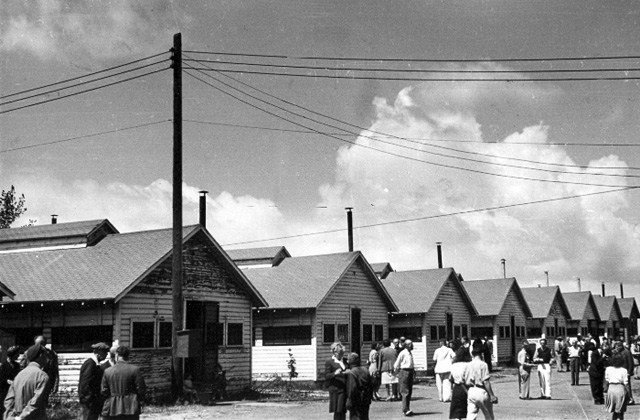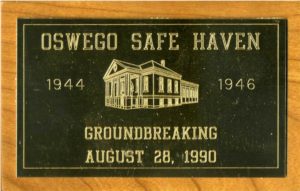
From August of 1944 to February of 1946, 982 refugees, who were mostly Jewish, lived as “guests” of President Franklin Delano Roosevelt (FDR), circumventing the rigid immigration quotas, at the Fort Ontario Emergency Refugee Shelter on the grounds of the former military fort. On June 12, 1944, FDR announced the plan after pro-Jewish organizations lobbied to push for the camp to be set up, which included First Lady Eleanor Roosvelt, who personally visited the site. The President charged Secretary of the Interior, Harold Ickes with the task of establishing the camp. Ickes tapped Jewish-American writer and journalist Ruth Gruber to secretly travel to Italy and bring a group of refugees to Oswego. Those selected were carefully screened to ensure they could successfully run the camp. Many of the families of men, women, and children had previously been held in concentration camps and escaped. Initially, the refugees were to only stay in the country temporarily and in fact were required to sign a document saying they agreed to return to Europe once the war was over.
While the camp was an improvement over their previous conditions in Italy and elsewhere, and certainly some individuals were saved from certain death had they remained in Europe, the inhabitants of Fort Ontario were not completely free. The camp was surrounded by a tall barbed wire fence and military soldiers were a constant presence. Individuals were required to have special identification papers and passes to leave the grounds to attend school or do other activities. However, life continued and there was some semblance of normalcy. People married, children were born, bar mitzvahs celebrated, there was even a Cub Scout troop.
 In December of 1945, there was to be a change in American immigration practice, particularly concerning Jewish refugees. President Harry Truman pushed for a return to pre-war immigration quota levels as outlined by law. An article reprinted in the December 22, 1945 Syracuse Herald Journal from The New York Times, describes the political tension of these policies. Immigration quotas from areas of Europe were set at 39,000 annually and the application process and admittance would continue to require sponsorship by a welfare organization. Any fees or costs incurred must also be covered and not burden the American government. However, consideration would extend to the refugees at Fort Ontario and through the efforts of dedicated local residents and other citizens, many chose to stay in the Oswego area permanently.
In December of 1945, there was to be a change in American immigration practice, particularly concerning Jewish refugees. President Harry Truman pushed for a return to pre-war immigration quota levels as outlined by law. An article reprinted in the December 22, 1945 Syracuse Herald Journal from The New York Times, describes the political tension of these policies. Immigration quotas from areas of Europe were set at 39,000 annually and the application process and admittance would continue to require sponsorship by a welfare organization. Any fees or costs incurred must also be covered and not burden the American government. However, consideration would extend to the refugees at Fort Ontario and through the efforts of dedicated local residents and other citizens, many chose to stay in the Oswego area permanently.
The buildings at Fort Ontario where the refugees had been housed were knocked down in the 1950s. Today Safe Haven Museum and Education Center has been established in the former residence of the camp administrator, Joseph Smith. The center is open to the public and visitors can learn more about the story of the refugees and those who helped save their lives.
Many of the refugees became successful doctors, lawyers, and businessmen. One was part of the team that developed the world’s first CAT scan. Another worked in espionage, helping to dismantle atomic bombs in Russia. Almost all went on to raise families.

